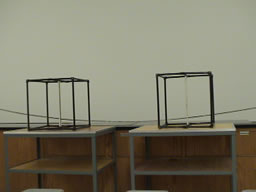Demos: 7B-21 Polarization Simulator

Directions: Set the frames on the table so that the two vertical slots are in the same direction. Take the spring and shake it up and down in the same direction as the slots. Then shake the spring in a direction perpendicular to the slots. Finally, turn the second frame 90 degrees to the first. Show that no matter how you shake the spring, no wave gets through.
Suggestions for Presentation: A good analogy to this is a picket fence. Ask the students what should happen if you tried to send a wave down a rope that passes through a picket fence. If the rope is wiggled in random directions, only that portion that has a vertical component will get through the fence. If another fence behind it is turned on its side, no wave can get through.
Note: Because the slots in the frame are of finite size, some disturbance still gets through, even when the frames are oriented orthogonally. However, you should emphasize the difference when the wave does pass through normally.
Applications: This a mechanical analog to crossed polarizers.
Last Updated: Nov 30, 2023 11:25 AM